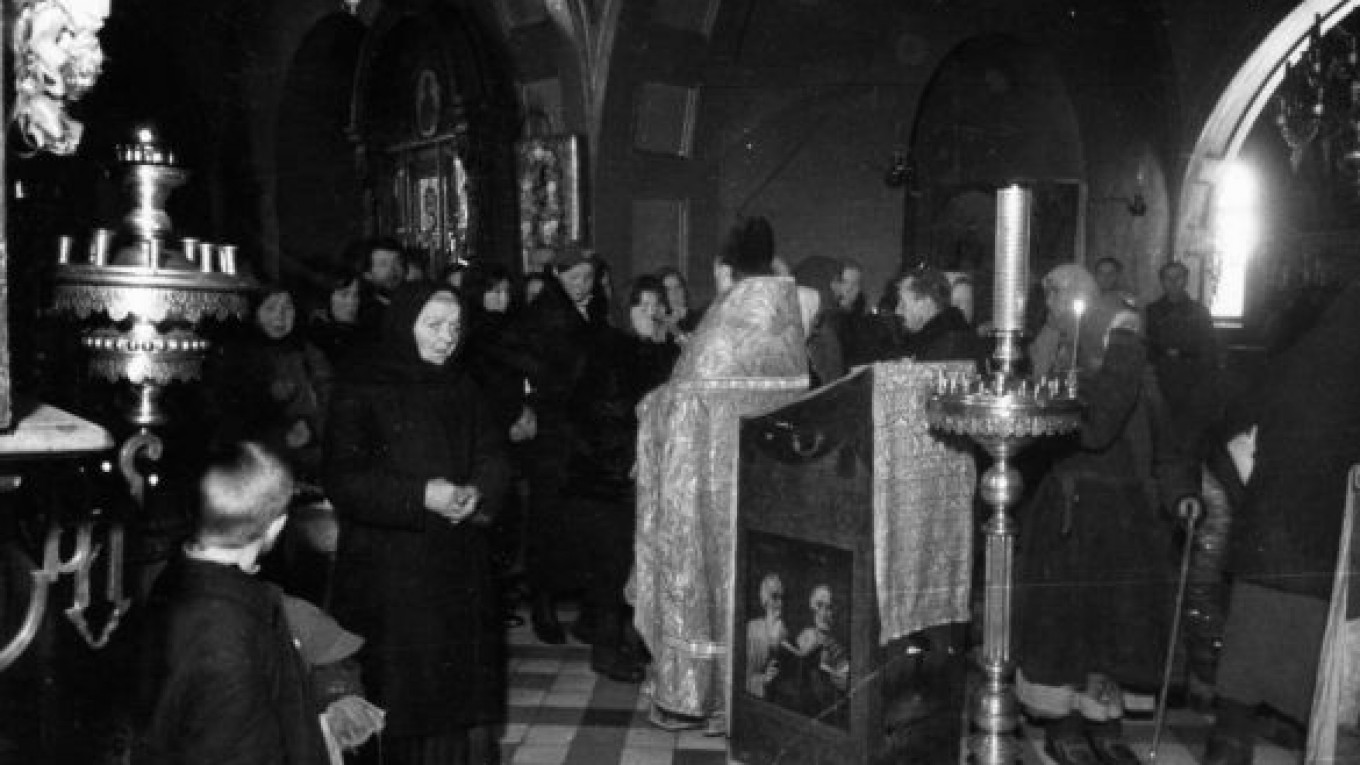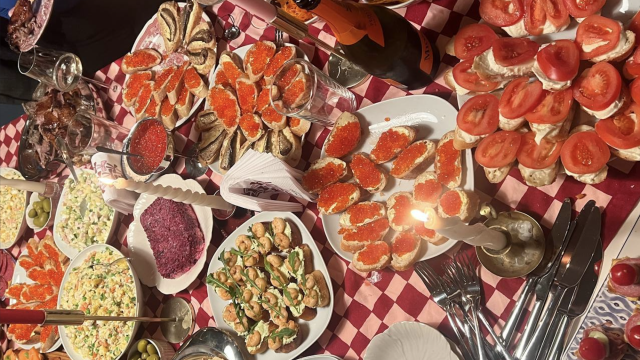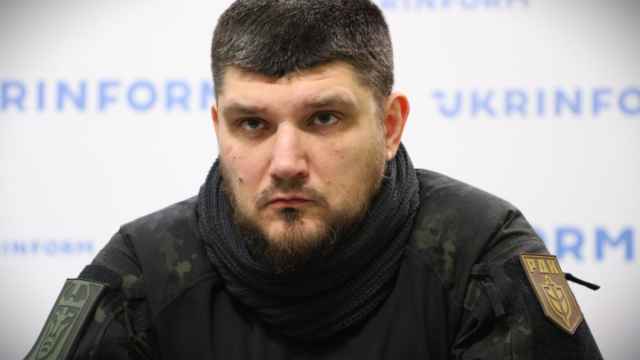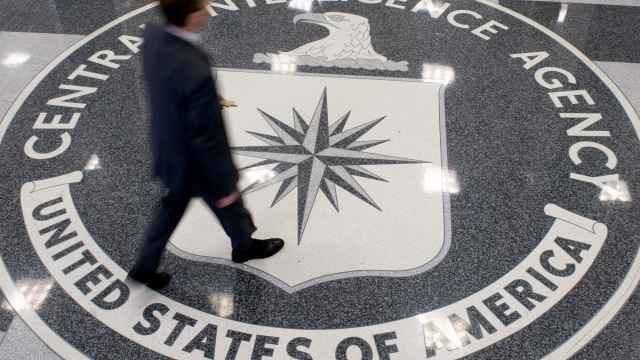After the end of World War II, Paul Sadler returned home to Chicago with three German books and a photo album from the Dachau concentration camp.
It was the photo album that caught his son's attention about 60 years later. And he began to piece together the story behind the war-time pictures, many of which were taken in the Soviet Union.
It was about three years ago that the son, Bruce Sadler, noticed the photo album, abandoned and falling apart, in the attic of his home in Evansville, Indiana.
"I delicately took the photos out of the album, scanned them and realized that there were writings on the back," Sadler, 56, said by telephone from the United States.
Since that time he has been investigating the mystery behind each of those 200 photos. He believes the pictures were taken by a well-placed German, possibly a Nazi soldier and definitely a spy on Soviet soil.
The photo album was discovered by his father in the liberated concentration camp in Dachau, which his military unit helped guard. Together with the album, he brought home three hardcover books published by a cigarette company in 1936: two about the 1936 Olympics and the third about the life of Adolf Hitler. All were forgotten in the attic for decades.
With the help of German writing on the back of some photos in the album, Bruce Sadler has identified about 20 of them and gained an insight into previously unknown pages of World War II.
"I've found a lot that hasn't been talked to us in schools here in the States," Sadler said. "It's just shocking. … Josef Stalin was just as vicious as Hitler in killing people, Russian citizens there."
Two of the pictures in the album were taken inside a crowded church in the Tver region town of Rzhev and dated Dec. 10, 1941.
"I found that in January, maybe three or four weeks after the picture was taken, Stalin ordered that town destroyed so that it wouldn't fall into the enemy's hands," Sadler said.
He contacted a Russian author who had written a book about the battle in Rzhev and learned that Soviet soldiers had nearly destroyed everything in the town, located 150 kilometers west of Moscow, in their eagerness to prevent it from being seized by Nazi troops.
The author also told him about a Rzhev "church that had all these people inside of it with explosives — they were going to blow up all these people, but for some reason they did not go off," Sadler said. "Maybe it was that church where the picture was taken."
During his research, Sadler determined that the pictures had been taken by a German with close ties to the Nazi military, including senior officers. Apparently the photographer was not an amateur.
"The pictures were definitely taken by a professional," Sadler said, explaining that an ordinary soldier would not have had the equipment to produce such high-quality pictures. "I was told that the quality of paper is the best one could get at that time … [and] was also used by Nazis at that time."
The occasional scratches in German on the back of the photos reveal that the photographer started taking them in France back in 1933 and continued though France's surrender in 1940. Others show Minsk and a radio factory there, while several feature Russian peasants and villages.
But many of the rest are unsigned and difficult to place.
The pictures include battle scenes as well as Nazi soldiers marching, resting in the shade, or joyfully dining. A few carry official stamps reading "not censored by the military and political departments."
Sadler said he would like family members of those pictured to find and identify their loved ones and receive copies of the photos. For that reason he has scanned and uploaded the pictures onto the Internet.
"I know the photos of this war as well as any historian, and I hadn't seen these before," Robert Citino, a historian with the University of North Texas, wrote about the album on Historynet.com.
Once Sadler wrote to Dachau to ask about identifying the possible photographer, but he received a letter back saying the turnover of soldiers in the camp had been high and it would be impossible to determine which one it was nowadays.
A few of the photos have gone on display in the Holocaust Museum in Washington. Copies of those from Rzhev can be seen at a local museum.
"I'm happy with what I've accomplished. My Dad would have been thrilled to see all the work that I've done," Sadler said.
Sadler, a caregiver by profession, said the reason why so many years had passed before he picked up the photo album was mainly because his father had found it painful to recall Dachau.
Dachau was the Nazis' first concentration camp, established in 1933. U.S. forces liberated the Bavarian town of Dachau in April 1945. When they arrived, they found dozens of train cars filled with the bodies of dead prisoners abandoned on the tracks. To avoid the mass liberation of prisoners from other camps, the Nazis had been moving them to Dachau, often without food or water.
"He could not talk about it," Sadler said of his father. "He was able to talk about the training going on in the army, going to France, etc. But when it got to the Dachau, he would stop. He would break down and cry and wouldn't go any further."
Only about a year before his death in January 2011, Paul Sadler was able to tell his family that the photo album in the attic had come from Dachau.
See more pictures .
A Message from The Moscow Times:
Dear readers,
We are facing unprecedented challenges. Russia's Prosecutor General's Office has designated The Moscow Times as an "undesirable" organization, criminalizing our work and putting our staff at risk of prosecution. This follows our earlier unjust labeling as a "foreign agent."
These actions are direct attempts to silence independent journalism in Russia. The authorities claim our work "discredits the decisions of the Russian leadership." We see things differently: we strive to provide accurate, unbiased reporting on Russia.
We, the journalists of The Moscow Times, refuse to be silenced. But to continue our work, we need your help.
Your support, no matter how small, makes a world of difference. If you can, please support us monthly starting from just $2. It's quick to set up, and every contribution makes a significant impact.
By supporting The Moscow Times, you're defending open, independent journalism in the face of repression. Thank you for standing with us.
Remind me later.






